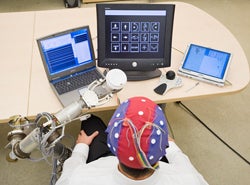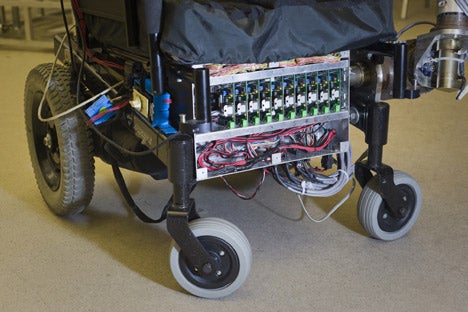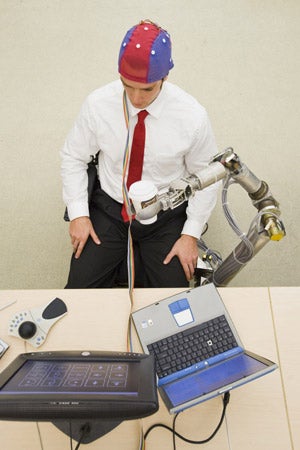 Researchers at USF have created a wheelchair with a robotic arm that is operated by capturing the user’s brain waves and converting them into actions, such as typing. This is just another example of a string of recent successes that heralds the coming revolution in brain computer interfaces (BCI) that is steadily underway.
Researchers at USF have created a wheelchair with a robotic arm that is operated by capturing the user’s brain waves and converting them into actions, such as typing. This is just another example of a string of recent successes that heralds the coming revolution in brain computer interfaces (BCI) that is steadily underway.
In addition to a BCI controlled robotic arm, the wheelchair also includes a 3-D joy-stick, keypad, and touch screen, demonstrating the increasing versatility and functionality that technology can deliver to the disabled. As pointed out in our recent post about the Immaculate Prosthetic Arm, the day will eventually come when these limbs, tools, and attachments will actually exceed the abilities of normal human physiology. At this point prosthetic arms and wheelchair attachments for the disabled would quickly move into the domain of “normal” people, used to enhance completely normal body parts and functions.
The wheelchair uses a noninvasive (non-surgical) approach to extracting the intentions of the user. A special helmet is worn that can detect brain waves known as P300 waves. We have adapted an explanation of how this works from wikipedia:
A 6×6 grid of characters is presented to the subject, and various columns or rows are highlighted. When a column or row contains the character a subject desires to communicate, the P300 response is elicited. This P300 response is captured by the helment and converted into an action by the robotic arm to type (or sent directly to the computer if desired). Results from studies using this setup show that normal subjects could achieve a 95% success rate at 3.4-4.3 chars/min, and trends suggest that 40 chars/min is the maximum theoretical limit achievable.
USF researchers claim that the robotic arm can be controlled “without the user moving a single muscle”.
From the USF release:
The WMRA (wheelchair-mounted robotic arm) holds particular promise for persons suffering from “locked-in syndrome,” a totally paralytic condition that leaves people unable to move but intellectually normal, a condition that has gained greater attention thanks to the book and subsequent movie The Diving-Bell and the Butterfly. Even in its development stage, the WMRA offers hope for a better quality of life for people with all levels of mobility challenges.




